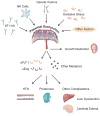Preeclampsia, a disease of the maternal endothelium: the role of antiangiogenic factors and implications for later cardiovascular disease
- PMID: 21690502
- PMCID: PMC3148781
- DOI: 10.1161/CIRCULATIONAHA.109.853127
Preeclampsia, a disease of the maternal endothelium: the role of antiangiogenic factors and implications for later cardiovascular disease
Figures




References
-
- Acog practice bulletin. Diagnosis and management of preeclampsia and eclampsia. Number 33. Obstet Gynecol. 2002 Jan;99:159–167. - PubMed
-
- Berg CJ, Mackay AP, Qin C, Callaghan WM. Overview of maternal morbidity during hospitalization for labor and delivery in the united states: 1993-1997 and 2001-2005. Obstet Gynecol. 2009;113:1075–1081. - PubMed
-
- MacKay AP, Berg CJ, Atrash HK. Pregnancy-related mortality from preeclampsia and eclampsia. Obstet Gynecol. 2001;97:533–538. - PubMed
-
- Liu A, Wen SW, Bottomley J, Walker MC, Smith G. Utilization of health care services of pregnant women complicated by preeclampsia in ontario. Hypertens Pregnancy. 2009;28:76–84. - PubMed
-
- Thadhani R, Ecker JL, Kettyle E, Sandler L, Frigoletto FD. Pulse pressure and risk of preeclampsia: A prospective study. Obstet Gynecol. 2001;97:515–520. - PubMed
Publication types
MeSH terms
Grants and funding
LinkOut - more resources
Full Text Sources
Other Literature Sources
Medical

